This article is the joint work of Neil Johnson and myself.
SSM2164 Power Rail Failure
Description:
The popular SSM2164 quad VCA from Analog Devices, and its clone the V2164 from cool audio (we'll stick to the original name), exhibits a rather bad failure mode:
1-The SSM2164 exhibits a catastrophic failure mode when the V+ pin is
powered and the V- pin disconnected . The symptom is massive current
flow
into V+ pin resulting in internal heating, which, if not limited,
results in destruction of the die.
2-In a modular synthesizer there is the possibility of accidentally
disconnecting the negative rail. For example, the power supply could
trip its negative output and disconnecting while moving cases. If this
should ever occur then
all the SSM2164 devices that are in the
modular
synthesizer will be destroyed.
It is therefore especially important to protect the SSM2164 in these types of open systems (i.e., where users can add and remove modules themselves): In closed systems, where a supply connection can be tampered with, this situation is very much less likely, but we feel that the information presented on this page may still be relevant.
Best Solution:
By far the best solution we have devised consists of adding a single Schottky diode with its anode connected to the V-pin (pin9) and its cathode to Ground (pin8).
It appears that if the V- rail is disconnected the diode provides a safe path for current to safely flow out of pin 9 (V-) to ground without causing any damage to the SSM2164. The suspicion is that there is some sort of parasitic crow-bar that is triggered when the V- pin rises one diode drop (about 0.6 V) above ground. The Schottky stops this happening by hard-limiting the V-pin to about half of that (about 0.3V)
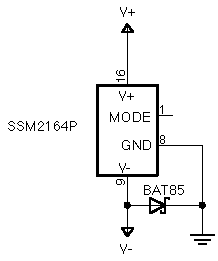
To prove
this solution the following experiment was conducted:
1-A 100Ω resistor was placed in series in the positive supply to pin
16 to limit the fault current to about 94mA
2-Current flow into pin 16 under test conditions(worst case signal and
control voltages) was measured at 10mA (typical about 5mA)
3-When the negative supply was disconnected, the pin 16 current
immediately rose to 94mA indicating fault condition.
4-Adding a BAT85 Schottky connected with its anode to pin 9 and its
cathode to pin 8 the current into pin 16 dropped to 0mA
Note: if the V- rail drops to 0V as opposed to disconnected, so that current can still flow into the V- rail, the SSM2164 behaves the same safe way. It is only in the situation where the V- rail is completely disconnected that this fault occurs.
Reverse Polarity Sensitivity: (Edited:1/28/2014)
Remember that the Schottky diode is connected
between the negative supply and the ground. So, in the case that,
accidentally, a synthesizer's module was reverse connected*, the Schottky diode could be destructed.
The very same thing occurs to the
SSM2164.
Therefore, it is recommended to use some reversal
polarity protection when using the "Power Rail
Failure Protection" described in this article and the SMM2164.
* (The positive supply to the negative terminal and the negative supply to the positive terminal)
Potential Solutions:
The following solutions were also evaluated in this study. They all provide some level of protection, but none are as satisfactory as the preferred solution described above.
| |
Schematic | Advantages | Disadvantages | Notes |
| Simple Series Resistor | 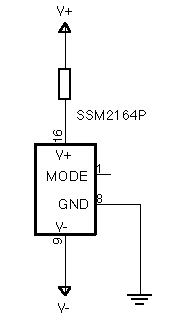 |
Lowest
component
count: 1xR Very easy to implement on existing modules |
Considerable
voltage drop under
normal operating conditions could adversely affect performance |
Useful for monitoring fault current during experimenting, but probably not useful in practical applications. |
| PNP Current Source | 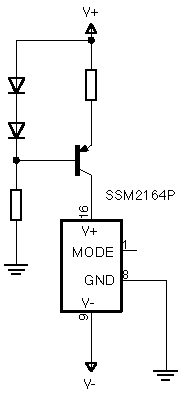 |
Quite easy to implement on existing modules. | High
component
count: 1xQ, 2xR,
2xD In fault mode the transistor will get warm. There is also the small issue that there is about 1V drop in the V+ supply rail to the SSM2164 which may be important in lower-voltage systems. |
|
| LM334 Current Source | 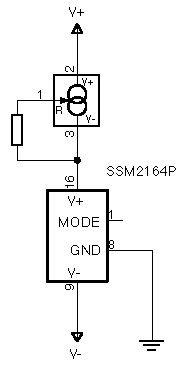 |
Low component count: 1xR, 1xQ | Positive supply rail reduced by about 500-600mV. | Has been tested,
10mA that the
LM334 provides will cover normal operation, but it might be better to
consider a source that provides something like 20mA. This solution was suggested by Steve Lenham on the synth-diy list. |
| Transistor Switch | 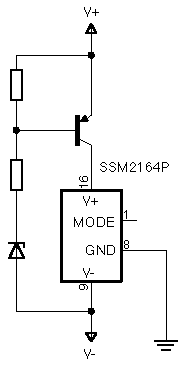 |
Very low supply voltage drop (typ. 300mV) | High component count: 2xR, 1xQ, 1xD | Probably the
second-best
solution if not for the component count. Could use a low-RDS(on) MOSFET for even lower voltage drop. |